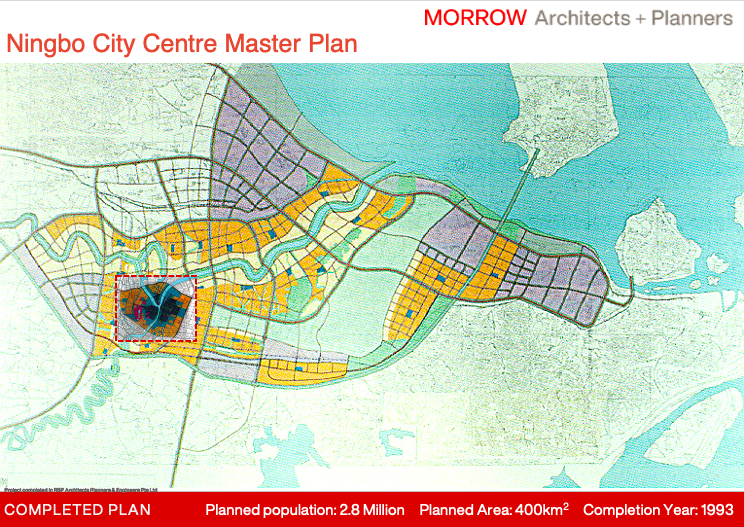
Dr Liu shares the urban plans he did for Ningbo (Source: Li Xiaoyu, Xinhua News Agency)
Dr Liu Thai Ker, founding chairman of MORROW Architects and Planners, former Chief Planner and Chief Executive of Singapore’s Urban Redevelopment Authority, and former Chief Architect and Chief Executive of Singapore’s Housing and Development Board (HDB), is frequently known as the founding father of modern Singapore Urban Planning. Having turned 84 this year, he has been involved not only in the urban planning of Singapore, but also dozens of cities across China and worldwide.
Having been involved in three urban planning projects for the city of Ningbo in the Zhejiang Province of China, Dr Liu shared more about the urban planning for this city in an interview with Xinhua News Agency earlier in April. Pointing out the reasonableness of developing Ningbo into a modern coastal metropolis, Dr Liu highlighted the importance of not just using modern technology and materials, but also adopting modern concepts in the planning process.
The Urban Planning Environment in China
China has long been an agricultural country and had a later start in understanding urban planning, which makes some of the urban planning in some Chinese cities less than satisfactory. However, the country was able to meet two out of the three conditions that Dr Liu believed Singapore’s success to be attributed to. In fact, these conditions in China were optimal, and not what many countries were lucky enough to have. For example, the Chinese government has more power over the implementation of plans, and is able to select the best sites needed for development due to public ownership of land in China.
Firstly, Singapore has a strong executive government. Secondly, the Land Acquisition Act enacted in 1966 allowing government acquisition of private land for more appropriate public development over private ones was well supported by the public. Lastly, Singapore has an understanding of urban civilisations — something that has also helped Dr Liu understand urbanisation better as a planner.

Shanghai, a city with a population of 26.32 million as of 2019 (Source: Shutterstock)
Turning Megacities into Constellation Cities
Dr Liu also pointed out that Chinese cities such as Beijing and Shanghai with populations of more than 20 million encountered more issues with urban planning that Singapore did not have to face, as its population is under 6 million till today. He compared this to concentrating the entire mainland population of Australia into just one city, which would pose huge problems. While there does not seem to be reasonable solutions to the problem of megacities, Dr Liu has proposed the concept of constellation cities to treat the cities within a megacity as independent, yet interrelated during planning.
Approaching the planning by treating the entire megacity as a human body but with the weight of up to six people, it is thus crucial to distribute the ‘weight’ of this body to several healthy bodies to ensure the health of the megacity. Adoption of technology to supplement the city — like how vitamins supplement human health — can then promote the construction of a smart city from a well-planned one. Taken together, the goal of intelligent urban planning is then achieved.
Three Key Elements of Urban Planning
As previously shared in a series of e-modules conducted by the Centre of Liveable Cities (CLC), Dr Liu talked about the three key elements of urban planning — a humanist heart, scientist mind, and artist eyes.
A planner needs to consider both the needs of the land and the people, protecting the natural environment while improving the people’s lives through well-planned infrastructure. Building an iconic city is hardly just about putting together a collection of iconic buildings. Having a scientist mind allows planning to be guided by good data in order to select the most appropriate components for the city. The final touch comes from the artist’s eye, which should see planners evoke a sense of beauty through understanding the land and its conditions.
In addition, Dr Liu believes that for the success of Singapore’s urban planning, another key point is to ensure the unity of the planning scheme. The HDB is the only department responsible for the construction of public housing in Singapore, and the policies implemented are not different depending on the income level and ethnicity of residents. Therefore, there are no ethnic villages and slums in various public housing areas in Singapore.

Dr Liu’s 1993 Master Plan for Ningbo’s city centre

Dr Liu’s 2018 Master Plan for North Ningbo
An “Affinity” with Ningbo
Having done the urban planning for Ningbo not just once, back in 1993, but again in 2018 for North Ningbo, Dr Liu believes this is his affinity with the city.
“It is a reasonable idea to build Ningbo into a ‘modern coastal metropolis’,” said Dr Liu.
The first consideration was that modern technology and materials should complement an equally modern concept to build a contemporary city. With Ningbo being one of the main ports of the Zhejiang province, its location also made it suitable for development as a seaport. In leveraging Ningbo’s strategic location and developing it into a coastal city along the likes of those such as New York and Shanghai, Dr Liu emphasised that some coastal areas should still be set aside for the enrichment of the people.
In his closing comments, Dr Liu suggested that Ningbo should focus on the population issue and keep it at around 13 to 14 million, even as the city builds itself up as a metropolis. To achieve this, it is advisable for the purpose of planning that Ningbo be further divided into two separate urban city areas, but remain connected for the interactions and transport convenience of the people.

This article was adapted from the original article in Chinese by Xinhua News Agency’s reporter Li Xiaoyu, here.


